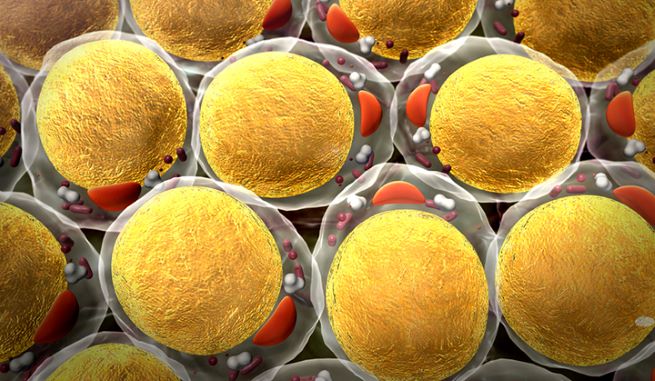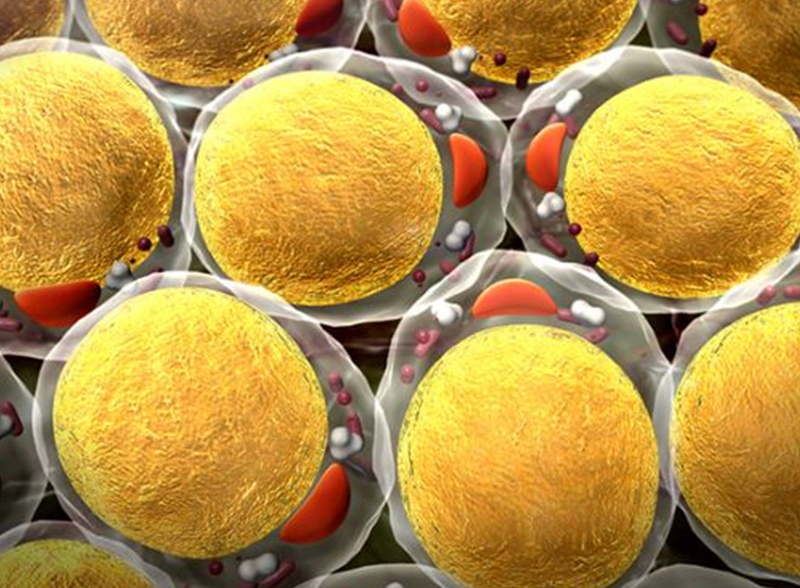Have you ever actually thought about what fat is? Maybe you thought it was just a storage depot, where excess energy hangs out? Like a garage? Just dead tissue? The truth is, fat cells really do have a secret life of their own.

Let’s talk about the secret life of fat…
The scientific term for fat cells is ‘adipose tissue’. You may have read about different types of adipose tissue: white and brown, which are not the same. Brown adipose tissue cells have more capillaries (tiny blood vessels), more mitochondria (the powerhouse part of a cell) and contain more iron, resulting in a darker pigmentation.
When we are born, we have a greater proportion of brown to white adipose tissue but, as we age, we develop more of the white stuff. Generally, brown adipose tissue is accepted as ‘good fat.’
White fat has fewer mitochondria and blood vessels than brown fat, thus resulting in its lighter white or yellow appearance. White fat is the predominant form of fat in the body, originating from connective tissue. Its main job is to provide energy reserve in the body. Where there is adipose tissue there are also lots of adipokines or adipocytokines being produced by the fat tissue.
Adipocytokines are hormones and cytokines (or cell signalling proteins) secreted by adipose tissue (adipo = fat, cytos = cell and kinos = movement). Adipocytokines are a bit like messengers delivering information.
Here are five examples of different types of adipocytokines that fat cells ‘spit out’ on a regular basis and a bit about how they affect us:
- Resistin: This is a hormone. An aptly named hormone because it literally means ‘resistance to insulin’. In basic terms, resistin reduces the ability of other cells to respond to insulin, therefore resulting in higher blood glucose levels and potentially contributing to the development of insulin-resistant conditions, like type 2 diabetes (1).
- Plasminogen activator inhibitor–1: This is a protein that inhibits other substances in the body that help in the process of breaking down blood clots. So, therefore, when its overproduced in the body (due to an excess of fat cells) there is a higher risk of thrombosis (that’s blood clots in our blood vessels) and more risk of cardiovascular events (2).
- Pro-inflammatory molecules (such as TNF-alpha and interleukin 6): Research indicates that the adipocytokines secreted by fat cells in lean individuals are more likely to be anti-inflammatory in nature(3), whilst those produced in overweight people are more likely to be pro-inflammatory. Inflammation is associated with poor health and all chronic disease, so it’s definitely not a state we want to be promoting in the body.
- Sex hormones: Some sex hormones can be produced by adipose tissue, in particular, oestrogen. Again, there are a number of chronic health conditions linked to higher oestrogen levels and/or high oestrogen to progesterone ratios (e.g. breast cancer). In overweight men, circulating oestrogen levels are also notably higher than in leaner men, while testosterone levels are lower than average (4). Low testosterone can lead to low mood, low libido, low muscle mass and a host of other symptoms in males.
- Leptin: Leptin is a protein that communicates with the brain, signalling ‘fullness’, therefore plays a critical role in appetite control. Increased circulating levels in overweight people due to the higher amount of fat tissue producing leptin, has raised the concept of ‘leptin resistance.’ This is similar to insulin resistance in that the body may stop responding to the messages that leptin is trying to send the brain. This may be why some people struggle with appetite control and may rarely feel ‘full’ or ‘satisfied’ after meals.
We often hear about the risks associated with being overweight, but we rarely discuss why this is the case. It’s not just the stress on the body from carrying some extra weight – its far more complex than that, as you can see.
I know there were a lot of complicated names in that list above, but the message is simply this: being overweight is more complicated than just being overweight. And, I mean that in the kindest way possible.
In research studies, fat is generally referred to as an endocrine organ (hormone-producing organ) in its own right and scientists have isolated over 50 substances that are ‘spat out’ by fat cells. That’s 50 substances capable of talking to, interacting with and having an effect over the other cells in our body. And, as you can see, they definitely have some pretty significant effects!
I really believe this highlights the need to look at weight loss from a holistic viewpoint. It can not be about ‘eating less and simply exercising more’. In fact, this approach will probably serve to heighten inflammation even further! We really want to reduce inflammation, achieve hormone balance, improve insulin sensitivity, address the psychology of weight loss, incorporate appropriate movement and eat the right foods for the body, of course. Please consider all of this if you are looking for the right weight loss approach for you.
Meanwhile, we stand behind the personalized, research-backed program, Metabolic Balance, because we know it addresses all of these factors and more. And that is really the key to losing fat and keeping it off.
References:
- Resistin: Functional Roles and Therapeutic Considerations for Cardiovascular Disease
- Biochemistry of Adipose Tissue: An Endocrine Organ
- Adipose Tissue in Obesity-Related Inflammation and Insulin Resistance: Cells, Cytokines and Chemokines
- The Impact of Obesity on Male Fertility
- Obesity and Leptin Resistance: Distinguishing Cause from Effect

